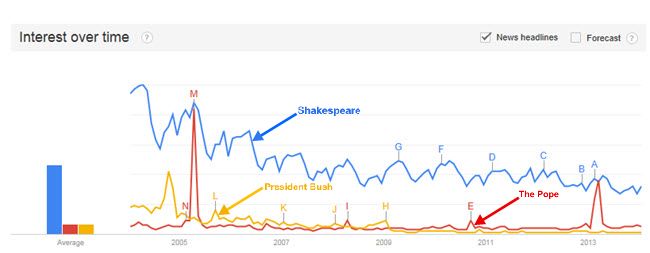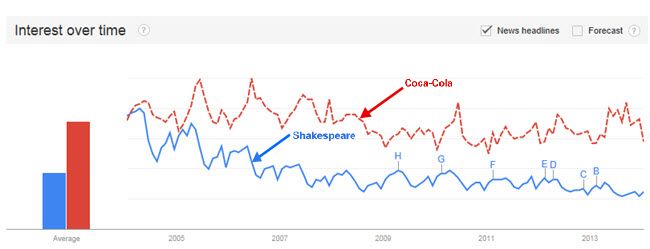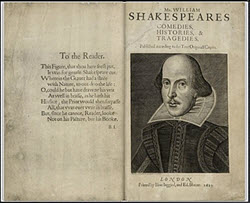A Branding Lesson from Shakespeare
 A Branding Lesson from Shakespeare
A Branding Lesson from Shakespeare
Shakespeare Is A Global Brand
What are the makings of a brand? It is a good question for any business to ask. Your branding relates to all interactions that your business has with it customers and potential customers.
I want to examine the “brand of Shakespeare” as a way to help us understand the making of a brand. Shakespeare remains in our minds today due to the strength of the brand. As a way to demonstrate this a want to compare Shakespeare’s search volume to some other established brands related to people (people as brands) using Google Trends. We will do this just to get some sense of where Shakespeare may lie on a people-as-brands awareness spectrum.
Google Trends is a useful tool that enables us to plot the search volume of one search term versus another. It is an easy and fast way to understand the popularity (search volume) over a time frame for specific phrases used in search. The graphs below shows us relative search volume versus time.
I decided to graph “The Pope”, President Bush and Shakespeare. The blue line is Shakespeare, the gold line is President Bush and the red line is the Pope. Note that The Pope is not a specific person but a person none-the-less. The spikes in the red line of The Pope are when Pope John Paul II was very ill in April of 2005 and then when Pope Benedict XVI resigned in February, 2013. Even with the spike in search volume the high points did not surpass the level of search volume for Shakespeare.
 .
.
In the 2nd graph (below) you can see that Shakespeare (again the blue line) even compares strongly against Coca-Cola (red line) which I may argue is one of the most recognized brands in the history of branding. When a playwright who died in 1616 can hold its own against a global branding giant such as Coca-Cola then clearly some powerful forces are at work. Let’s analyze this.
 .
.
What does Shakespeare stand for?
Brand Quality
The quality of the work is superb. The content is deep. The audience he was writing for was demanding. Even though a “commoner” could attend a play much of the work was done with the demands of the most intellectual, discerning and demanding audience of the time. This was the audience of the monarch’s court. In fact there is was even advice presented to the actors to not perform for the lower classes. Shakespeare wanted the actors to perform as if performing for the King.
Also, keep in mind that to perform on a stage at the time of Shakespeare was something very new. It went against the thinking of the time in mainstream London. In fact the theaters were not originally built within the City of London (within the wall) but rather outside the wall as the civic authorities of the time were not pleased with these performances. Shakespeare’s own theater – The Globe – was on the south side of River Thames along with The Swan, The Rose and the bear-baiting rings.
To gain a following the quality of the work had to excellent. It had to be entertaining. It had to delight a very discriminating and astute audience.
Advice: Define what your brand stands for and build this into your branding.
Brand Repetition
The Shakespeare brand is repeated in many ways and often.
The power of repetition is enormous. If marketers consider spending millions on a television advertising campaigns or if a business is prepared to print ads in newspapers and write articles supporting their brand then the content must have integrity and bear scrutiny – otherwise the effort and the investment may be wasted.
William Shakespeare has been on the curriculum in British and American schools for well over a century. There are few people in the English speaking world who do not recognize the name. The plays are equally enjoyed all over Europe. Moreover, a host of brilliant professors and academics analyze and repeat the brilliance of the author decade after decade.
Who is one to challenge them? The repetition of Shakespeare as a brand has been strongly repeated.
Advice: Make sure that you are consistent and reinforce and repeat your brand message.
Brand Perception
Was the name William Shakespeare a pen name? Perhaps – anyone can use a pseudonym.
Twelve of the thirty-six plays had hitherto not been printed, others had no author ascribed. They became William Shakespeare’s plays because they came out of the same “factory” and appeared in the first Folio which was published after his death.
There may have been some advertising “inaccuracies”. However, I will not go there now – it is a topic for another time. Now we are reviewing perception.
The advertising has led us to believe that there was a playwright, a genius called William Shakespeare; a man who could speak six languages, had an English vocabulary approaching 30,000 words (more than twice the vocabulary of the average American college student), had extensive knowledge of philosophy, medicine, the law, the flowers of the field and things nautical, who moved amongst the most exalted in the land, and yet of whom there is not one mention in a firsthand, contemporary letter relating to literature, or the theater.
Clearly the perception of William Shakespeare is one that has been carefully crafted and reinforced so that we hold the perception of Shakespeare at the highest level.
I will also have to note that his contemporary – Ben Jonson – himself a well-know playwright stated about Shakespeare at his death that “He was not of an age, but for all time.” To have a tribute such as this from a well-established contemporary competitor contributed to the perception at the moment of his death and has been carried forward ever since.
Advice: Create a persona and/or a perception that fits you brand and your marketing message. Craft this well to enhance your branding.
Brand Logo
Many of us can form an image in our minds of Shakespeare. This image that we form most likely has come from the engraving at the front of the first Folio of the Works of William Shakespeare published in 1623 – 7 years after his death.
On the opposite page is a poem written by the poet Ben Jonson suggesting the reader should not dwell on the portrait, but concentrate on the works contained in the book. None-the-less our image of William Shakespeare is etched in our minds and this image and various versions of it are easy to summon up.
The advertising objective of the marketers of the First Folio was to sell an expensive book. The marketing campaign was put together by people of great intelligence. The image and versions of it have been repeated countless millions of times.
Today, we have an easy associations with the image (logo) of Shakespeare and what it means to us. This is branding. Easy associations so that we do not have to work too hard to figure out the meaning of something. Good branding enables us to make associations quickly and efficiently and this helps us to make decisions.
Advice: A logo or an efficient graphic is important for your branding. When people can make associations easily when they see your logo or graphics then you are using graphics effectively.
The “product” of William Shakespeare is robust, of the highest quality, well presented and the message is constantly being reinforced – this is what makes a brand. I hope you enjoyed this branding lesson from Shakespeare.

